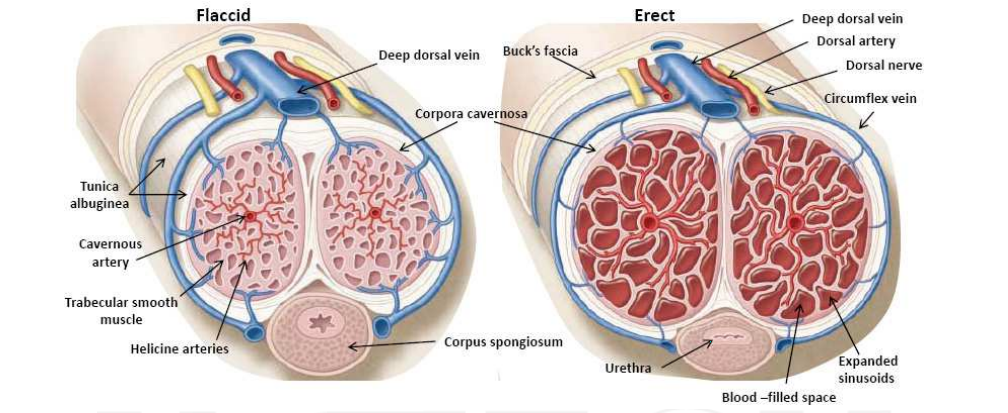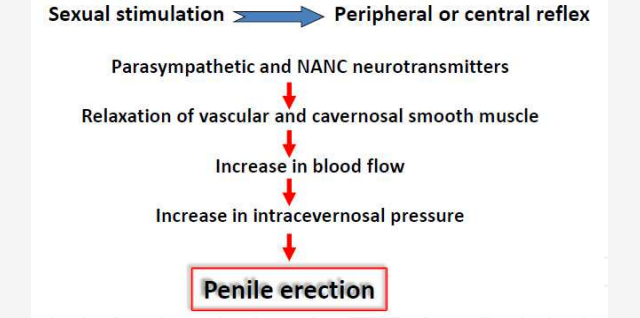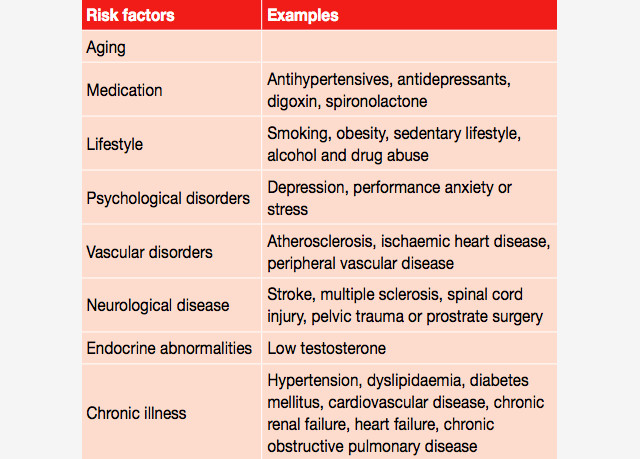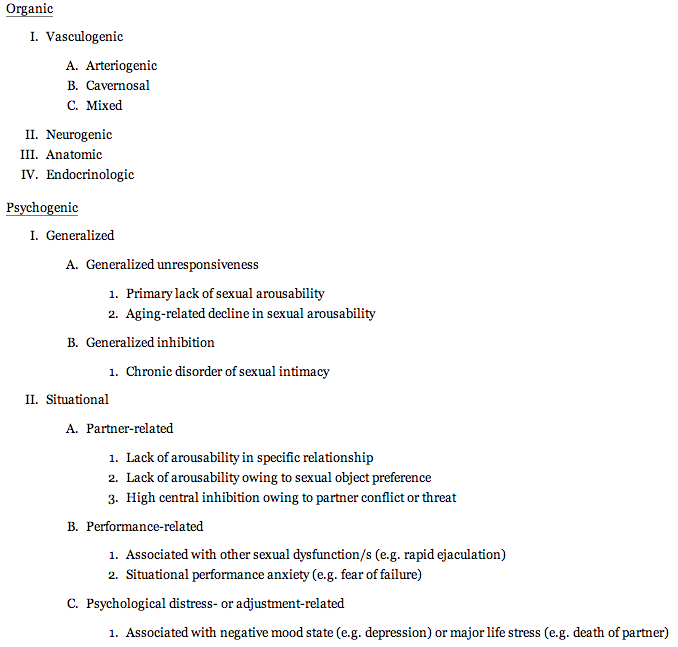For many men, getting an erection is as simple as breathing. But it’s an incredibly complex process involving a precise sequence of psychological and physiological events that can easily go wrong. Here’s how erections work — and how science is helping millions of men keep it up.
Back in 1992, the U.S. National Institutes of Health organised a conference on impotence. One of it’s primary recommendations was to do away with the term itself, replacing it with the now standard “erectile dysfunction,” or just ED.
Erectile dysfunction is defined as the inability to get or keep an erection firm enough to have satisfactory sexual intercourse, however you define that. It can describe a complete or inconsistent inability to achieve an erection, or a tendency to sustain only brief erections.
Today, the NIH estimates that ED affects some 30 million men in the United States alone. As is well known, incidence increases with age; about 4% of men in their 50s and nearly 17% of men in their 60s experience a total inability to achieve an erection. After the age of 75, it jumps to 47%. Given our ageing population, this is quickly becoming a public health issue. ED can impact negatively on a man’s well being, relationships, and quality of life. It’s estimated that, by 2025, some 300 million men will experience ED.
From the Brain to the Sponge
To understand what causes it, and how doctors are treating ED, it’s important to understand how erections work.
For centuries, scientists have understood that the two paired cylinders within the penis, the corpora cavernosa, when trapped with blood, are responsible for the rigidity of an erection. But as late as the 1980s, scientists still weren’t sure how the blood became trapped within the penis in the first place.
Indeed, without some kind of mechanism to trap the blood that’s released during the initial stage of the erection, the increased blood flow stemming from sexual arousal would just flow into the penis and then flow out through the veins, making the penis full — or tumescent — but never hard. Interesting, there’s no other part of human anatomy with a draining system that allows blood to leave at one time and then change to a system where the blood is trapped at high pressures.
Today, scientists have solved the mystery through an increased understanding of the corpora cavernosa. The interior of these cylindrical structures are like a sponge, with cavernous spaces lined with smooth muscle.

As every man knows, an erection starts in the brain. Sensory or mental stimulation (i.e. sexual arousal) is followed by a burst of a brain chemical called nitric oxide which functions as a neurotransmitter.
Nitric oxide causes the smooth muscle enzyme guanylate cyclase to produce a messenger called cyclic guanine monophosphate (cGMP), which acts to increase the size of blood vessels carrying blood to the penis, and decrease the size of vessels carrying the blood out.

When the smooth muscles are relaxed, blood can flow in through the arteries and fill the spaces. This influx of blood creates pressure in the corpora cavernosa, making the penis expand. The tunica albuginea then acts like a trap door, keeping the blood in the corpora cavernosa, allowing for sustained erections.
The whole thing comes to an end when muscles in the penis contract to stop the inflow of blood and open the veins for blood outflow.
Potential Points of Failure
Decades ago, scientists figured that the majority of ED (upwards of 90% of cases, in fact) could be attributed to psychological factors, which was dubbed ‘psychogenic impotence.’ But we now know there’s much more to ED than what’s in your head.

Image: CPD
Needless to say, erections are a complex physiological and psychological process with many potential points of failure, including nerve impulses in the brain (nearly 20% of ED is of neurogenic origin), the spinal column, the area around the penis, and the response in muscles, fibrous tissues, veins, and arteries in and near the corpora cavernosa. Any of these areas of anatomy, and/or the precise sequence of events, when disrupted, can result in ED.
All sorts of classifications have been proposed for ED, some based on the psychological causes and some on the neurovascular and physical processes behind the erectile process.
Here’s how the NIH breaks it down:

Typically, ED has an underlying physical cause, such as disease, injury, or the side effects of drugs. ED is often the result of injury to the nerves, or an impairment to how the blood flows to the penis.
The most common cause of ED is damage to nerves, arteries, smooth muscles, and fibrous tissues. This is often caused by a disease, including diabetes, high blood pressure, nerve damage, multiple sclerosis, atherosclerosis, and heart disease. Lifestyle choices are also a contributing factor, such as smoking, alcohol, obesity, and not exercising. Certain surgeries, like radical prostate and bladder surgery for cancer, can also cause ED.
There are also hormonal factors to consider, namely low levels of testosterone.
Many common medicines also produce side effects that can cause ED, like blood pressure drugs, antihistamines, antidepressants, tranquilizers, appetite suppressants, and cimetidine (an ulcer drug).
There’s also psychology to consider. ED can arise from feelings of stress, anxiety, guilt, depression, low self-esteem, and fear of sexual failure.
A Trove of Treatments
There are many treatment options, including psychotherapy, drug therapy, oral medications, injectable medications, vacuum devices, and surgery. Needless to say, treatment will depend on the underlying health condition. In many cases, such as heart disease or diabetes, the condition will need to be treated before treatment of ED can begin. And in some cases, treating the underlying cause resolves the problem of ED.
Changing Lifestyles
If ED is lifestyle related, men are typically asked to lose weight, give up smoking, moderate alcohol consumption, exercise, and reduce stress.
Psychotherapy
Doctors also recommend that some patients get treated psychologically, like behavioural therapy, to help decrease the anxiety associated with sex. Sometimes the patient’s partner can help with the techniques.
Better Living Through Pharmacology
Medications are usually the first thing men are prescribed when coping with ED. In the late 1990s, the first effective medication, sildenafil (Viagra), became available. It was soon followed by similar drugs like vardenafil hydrochloride (Levitra) and tadalafil (Cialis). They have been nothing less than revolutionary in the treatment of ED.
These drugs are classified as phosphodiesterase-5 (PDE-5) inhibitors, and they’re some of the most widely used and effective types of medication for treating ED. They work by temporarily increasing the blood flow to the penis. These drugs, which are taken just prior to sex, enhance erectile function during sexual stimulation by penetrating into smooth muscle cells and inhibiting PDE-5 — an enzyme that degrades CGMP (as noted, a compound that contributes to smooth muscle relaxation). Basically, PDE-5 increases relaxation of the smooth muscle, resulting in increased blood flow — and sustained erections.
Local Therapies
Both injectable and intraurethral agents have been around since the 1980s. Vasoactive drugs, when injected into the penis’s erectile tissue, can help to initiate and maintain an erection. Examples include Intracavernosal Prostaglandin E1 (PGE1; Alprostadil), Vasoactive Intestinal Polypeptide and Phentolamine, and Papaverine.
But owing to the effectiveness of PDE-5 inhibitors, these are now considered second line therapies. That said, they’re still useful for the 25-32% of men for whom PDE-5 inhibitors do not work or cause unwanted side-effects.
Vacuum Devices
These devices, called a vacuum constriction device (VCD), consist of a clear plastic tube that’s connected to a pump, which is either hand or battery operated. The pumped-out air creates a vacuum, which in turn causes blood to rush into the penis, causing an erection. A rubber ring is then placed around the base of the penis to keep the blood in place. This can allow for an erection to last for about 30 minutes. It takes practice, but 9 out of 10 men are able to have sex, regardless of the cause of their ED.
Surgery
If all else fails, there’s also surgery to consider. A common procedure involves penile implants, either semi-rigid implants (suitable for older men who don’t have regular sex) and inflatable implants (consisting of two or three parts that can be inflated to give a more natural erection). These surgeries are well established (being around since the 1970s), are expensive — but some 75% of men report satisfaction after getting it done. Regrettably, like with any surgery, penile implants can result in infections.
Future Therapies
Looking to the future, scientists speculate about novel ways of treating ED, including advanced pharmacotherapy, gene therapy (in which defective genes in the corporal tissue can be restored or the mutant gene antagonized), regenerative medicine (like nerve grafts), and a new drug called avanafil — a PDE5 inhibitor that’s currently going through Phase III clinical trials (which is being seen as a viable substitute for men who can’t take conventional PDE-5 inhibitors).
And last but not least, there’s always spider venom to consider; studies have shown that the Tx2-6 toxin of the Phoneutria nigriventer spider facilitates an erection. Well, at least in rats. Tx2-6 could be important for development of new pharmacological agents for treatment of erectile dysfunction.
Additional reporting by Joseph Bennington-Castro.
Other sources: NIH [Why Men Fake it [NHS]
